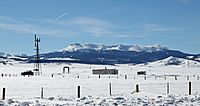Flat Tops (Colorado) facts for kids
Quick facts for kids The Flat Tops |
|
|---|---|
| Flattops | |

The Flat Tops as seen from State Highway 131 in Routt County
|
|
| Highest point | |
| Peak | Flat Top Mountain |
| Elevation | 12,361 ft (3,768 m) |
| Geography | |
| Country | United States |
| State | Colorado |
| Parent range | Rocky Mountains |
The Flat Tops is a unique mountain range in Colorado, USA. It is mostly found within the Routt and White River National Forests. A large part of this area is protected as the Flat Tops Wilderness Area.
What makes the Flat Tops special is its high, flat plateau. This plateau is made of old basalt rock, which came from volcanoes long ago. The plateau is surrounded by steep cliffs and deep valleys. These valleys were carved out by glaciers during the Ice Age.
This mix of flat, treeless areas (about 11,000 to 12,000 feet high) and green valleys is very rare in Colorado. The Flat Tops area has around 110 ponds and lakes. It is home to many different plants and animals.
Contents
Exploring the Flat Tops
The highest point in the Flat Tops is Flat Top Mountain. It stands tall at 12,361 feet (3,767 meters). This peak is located on the eastern side of the range.
The Devil's Causeway
One of the most famous spots in the Flat Tops is the Devil's Causeway. This is a very narrow part of the plateau. Long ago, glaciers on both sides almost met, leaving only a thin strip of land.
A hiking trail crosses the Causeway. At its narrowest, it is only about 3 to 4 feet wide. On either side, there are steep drops of hundreds of feet into the valleys below. It's a thrilling experience for hikers!
Getting There
You can reach the eastern side of the Flat Tops Wilderness Area from Yampa, Colorado. Just follow Routt County Road 7.
If you want to visit the western side of the range, a popular destination is Trappers Lake.
Wildlife and Nature
The Flat Tops is home to many large mammals. You might see moose, elk, mule deer, black bears, and cougars.
Plants and Trees
The most common trees in the Flat Tops are Engelmann spruce, subalpine fir, and lodgepole pine. At lower elevations, you can find groves of aspen trees.
The very top of the plateau is alpine tundra. This means it's a cold, treeless area with low-growing plants. Sometimes, a non-native plant called yellow toadflax can be found here.
Images for kids







